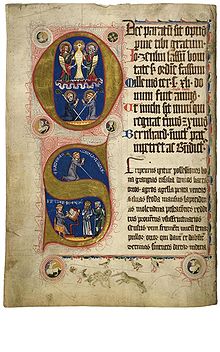Tennenbacher goods book
The Tennenbacher goods book (also Codex Tennenbach ) is a predominantly written in Latin, about 1,317 from Tennenbacher monk and later Abbot John Zenlin begun and 1341 bound Urbar , the ownership of the Cistercian monastery Tennenbach in Emmendingen recorded. In terms of scope and systematics, alongside the Habsburg Urbar, it is the most significant work of this type of text for the Upper Rhine regional history of the 14th century. The manuscript , which is now kept in the General State Archives in Karlsruhe, is also of outstanding importance thanks to the book design: the entrance is adorned with high-quality miniatures and the main text is adorned with numerous, colored initials .
The codex consists of 352 parchment sheets bound in layers, some of which were added later. In it the rights and possessions of the monastery are registered in a total of 233 locations - mainly in the old settlements of the Breisgau and in the adjacent areas. The recorded Tennenbacher Grangien and fiefdoms were distributed over a settlement area between Lare (= Lahr ) as the northernmost point seen from the monastery to Bellicon (= Bellingen ) in the south. In addition to the property rights, the Urbar also documents historical references to the founding of places and events in some places or supplements entries with theological considerations. The Tennenbacher Urbar is of particular importance not least because of the complete copy of the Freiburg city law from 1120. It introduces the description of Tennenbacher goods and rights in the city of Freiburg (Sp. 305-310). The oldest version of the deed of incorporation served as the model for the scribe.
After the initial creation, the land register was supplemented, corrected or maintained by various scribes in the following centuries, for example when changing ownership. The text has also been made more accessible with the help of page numbers, numbering and other aids for the intended use.
After the secularization of Tennenbach in 1806, the property book came to the Grand Duchy of Baden .
Individual evidence
- ↑ Introduction . In Tennenbacher Güterbuch , pp. XVI ff.
- ↑ GLA 66/8553
- ↑ Konrad Krimm: image and context. To the entrance miniatures of the Tennenbacher Güterbuch. In: ZGO , Volume 155, 2007, pp. 215–226.
literature
- Commission for historical regional studies in Baden-Württemberg (ed.): Das Tennenbacher Güterbuch (1317–1341). Edited by Max Weber and Günther Haselier, Alfons Schäfer, Hans Georg Zier, Paul Zinsmaier. (= Publications of the Commission for Historical Regional Studies in Baden-Württemberg: Series A, Sources; Volume 19), Kohlhammer Verlag, Stuttgart 1969.
- Konrad Krimm : image and context. To the entrance miniatures of the Tennenbacher Güterbuch. In: ZGO , Volume 155, 2007, pp. 215–226.
Web links
- "Monasteries in Baden-Württemberg" / Tennenbach Cistercian Abbey with zoomable detail of the entry page of the goods book.
